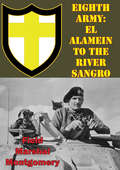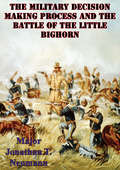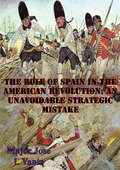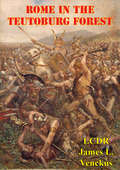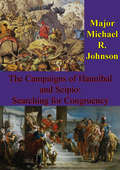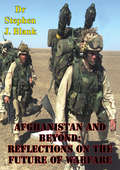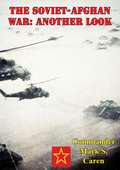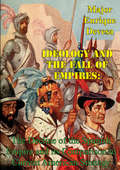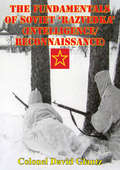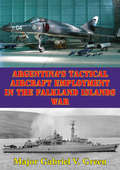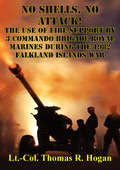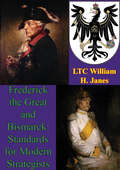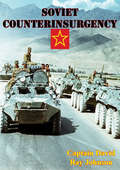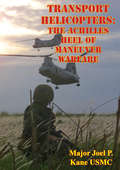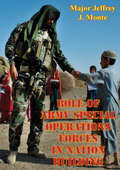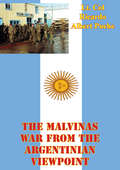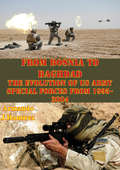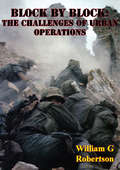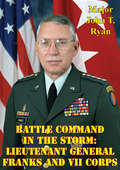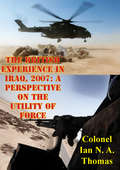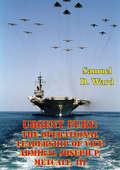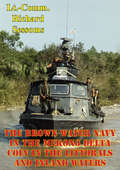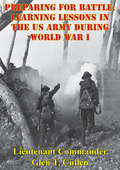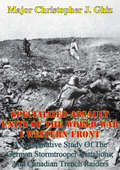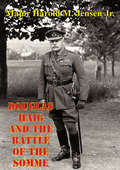- Table View
- List View
21 Army Group: Normandy To The Baltic [Illustrated Edition] (Memoirs Of Field Marshal Montgomery #1)
by Field Marshal Viscount Bernard Law Montgomery of Alamein KG GCB DSO PC[Illustrated with 46 highly detailed maps of the actions]Field Marshal Montgomery commanded the Eighth Army from 13th August 1942 until the 31st December 1943, and the 21st Army Group from 1st January 1944 until the German surrender on the 5th May, 1945. Whilst in command of the British Army of the Rhine, in occupation of Germany, shortly after the end of the Second World War Montgomery set out to record the exploits and victories of the troops under his command.Both this volume and its companion volume, El Alamein to the River Sangro, are superb examples of military history as presented by one of the greatest generals to command victorious armies in the field. The texts are taken from his personal war diaries and are distinguished by his incisive style. The whole strategy and course of these two campaigns are presented to the reader with great clarity and accuracy.In Normandy to the Baltic the Field Marshal unfolds that greater task -- the planning and implementation of the greatest invasion the world has ever known -- Operation Overlord. He describes the whole plan behind. D Day and the Battle of Normandy. He continues with the battle for Caen and the capture of Cherbourg, the closing of the Falaise Pocket and the crossing of the Seine--through into the Low Countries and the Battle of Arnhem and the famous Battle of the Ardennes. He concludes with the battle of the Rhineland, the crossing of the Rhine and the rush across northern Germany to the final surrender. The whole pattern of the complex allied effort -- British, Canadian and American -- is described with extraordinary detail and each episode is analysed in retrospect.
The Military Decision Making Process And The Battle Of The Little Bighorn
by Major Jonathan T. Neumann U.S. ArmyBased on his background, education, training, and the information available at the time of his attack, Lieutenant Colonel George Armstrong Custer made good decisions as he lead the 7th Cavalry in its defeat at the Little Bighorn.Custer received the standard pre-commissioning education that West Point used to mold all future Army leaders. That education served him well in the Civil War where he enjoyed tactical success and a meteoric rise to fame and high rank. Following that conventional conflict, Custer entered into world of irregular warfare and voluntary forces. His defeat at the Little Bighorn ended 10 years of development as an unconventional warrior. Despite the common perception that his decisions invited disaster, by using the current Military Decision Making Process, and the intelligence available to him professionals of today can recreate the command decisions he made that day in June 1876 and possibly conclude that they were not to blame for the defeat.Custer's military decisions are very similar to those a current leader would make using current military decision making doctrine.
The Role Of Spain In The American Revolution: An Unavoidable Strategic Mistake
by Major Jose I. YanizSpain played a significant role in the outcome of the American Revolution by providing economic support and opening war fronts to fight the British in Europe and North America. Spain's support for the revolutionaries was a strategic mistake for its government, for it was not in Spain's national interests as a colonial power to do this.Neither France nor Spain helped the North American colonies to gain independence from Great Britain for altruistic reasons. Instead, both countries were eager to retaliate against Great Britain, which had become the undisputed global power after these countries' defeat in the Seven Years War...However, Spain, unlike France, still possessed extended and rich territories throughout the two American continents. This caused Spain to cautiously approach involvement in the American Revolution. Being a colonial power like Britain, Spain did not want the seed of independence to spread throughout its own colonies; therefore the country never officially recognized U.S. independence during the time of the American Revolution. Instead, and as a result of the Bourbon Family Compact with France, Spain declared war on Great Britain in 1779, but it would never fight within the Thirteen Colonies.Nevertheless, and despite the inherent risk, Spanish ports were opened to American ships, and Spain provided, initially by secret means through Paris and New Orleans and later on in a more straight way, financial support to the American cause in the form of money and supplies since 1776. Spanish money also financed expeditions such as De Grasse's Fleet in 1781 and the Washington's army on its march to the south that were decisive in the Yorktown victory. Moreover, Spain fought the British in the Spanish areas of interest, including West Florida, Central America, the Caribbean, and Europe, thereby opening several fronts which the British could not simultaneously manage, and threatening vital sea lines of communications of the global naval power.
Rome In The Teutoburg Forest
by LCDR James L. VenckusThis paper examines the battle of Teutoburg (9 A.D.), its consequences on the Roman world, and the role cultural misunderstanding played on the tactical, operational, and strategic levels. The Roman commander's cultural misunderstanding of his enemy caused mistakes at the operational and tactical levels, while the Roman Emperor's cultural misunderstanding brought about mistakes at the strategic level and created poor policy decisions following the battle, which affected Rome like no other battle in its history. Chapter 2 examines the consequences of other Roman loses (with much higher casualties) to show how none of them carried the same impact as the Teutoburg loss. They were but temporary "setbacks", while Teutoburg was Rome's first military "defeat" in its history. The Roman direction of conquest into Germania and the image of the pre-Teutoburg Germanic barbarian (an image which changes greatly into an elevated status following the massacre) are also examined. Chapter 3 examines the commanders of both sides and the battle itself. Chapter 4 looks at the significance of this loss. This battle caused Rome to adopt its first permanent defensive boundary and set the first limit of the Roman Empire.
The Campaigns Of Hannibal And Scipio: Searching For Congruency
by Major Michael R. JohnsonThis paper analyzes the Second Punic War using the Contextual and Operational Elements found in the Campaign Planning Model to determine how Rome and Carthage conducted the war, and whether they maintained congruency as each respective country pursued their national objective. It examines how they selected their grand strategy, and how that strategy was interpreted and executed at the operational and tactical levels. The model highlights flaws in Carthage's formulation and application of its grand strategy which, combined with the lack of strategic insight at the operational level, kept them from satisfying their objectives. This paper also shows that Rome's formulation and execution of its grand strategy, even with several interim changes in operational strategy, flawlessly applied the tenets of the Campaign Planning Model and enabled Rome to always keep its strategic perspective firmly in view to secure eventual victory. This paper also recommends further study of Rome's operational strategy, in particular the campaign of its commanding general, Publius Cornelius Scipio. Scipio's campaign provides excellent examples of the principles of surprise and concentration, and demonstrates how innovation and mobility can produce an indirect strategy that can not only defeat a larger enemy, but also maintain flawless congruency with strategic objectives. Scipio provides an outstanding study in military genius, indirect strategy application, innovation, and statesmanship. He most closely embodies the soldier-statesman needed in modern coalition warfare.
Afghanistan And Beyond: Reflections On The Future Of Warfare
by Dr Stephen J. BlankMany military analysts believe or fear that the wars of the 1990s will be akin to the wars in the former Yugoslavia: small-scale but long-lasting and recurrent ethnic wars that also elude easy international resolution. There are consequently well-founded concerns about prospects for deployment of U.S. forces there in a unilateral or U.N. capacity. Some of the lessons of this kind of war were already apparent in the wars of the 1980s. They were known then as low-intensity conflicts and now as operations other than, or short of, war.This report focuses mainly on lessons from one of the most crucial of these wars, i.e., in Afghanistan as a result of the Soviet invasion in 1979, and attempts to draw lessons that are relevant for current wars, like those in Yugoslavia or the ex-Soviet Union. The purpose is to stimulate analysis and reflection on the strategic and operational, if not also tactical nature of these wars by both analysts and policymakers so that all interested groups can more easily come to terms with a form of warfare that promises to be both deeply destructive and deeply rooted in longstanding political and social antagonisms that cannot be easily or quickly resolved.Naturally some of the lessons drawn from Afghanistan and other wars may either only apply to Russian and Soviet forces or conversely may apply to war in general. But our primary intention is to make a contribution to the study of future wars particularly of the ethnic and small-scale type that promise to continue in many parts of the globe lest we devise better ways for averting and then resolving them.
The Soviet-Afghan War: Another Look
by Commander Mark S. CarenThis research effort reviews the Soviet military's involvement in Afghanistan from four general, perspectives: (1) systemic problems inherent in the Soviet military culture, (2) the use of surprise, (3) operational maneuver and the preeminence of aviation and (4) employment of mines and chemical weapons as an extension of maneuver warfare. This paper concludes that the lessons of this war have been learned by the Russians. There is every reason to believe that they can achieve the level of doctrinal changes required to be successful in future "local" interventions. It must be accompanied, however, by corresponding socio-military reform.
Ideology And The Fall Of Empires: The Decline Of The Spanish Empire And Its Comparison To Current American Strategy
by Major Enrique Gomariz DevesaSometimes, the ideology that formed the basis for founding an empire can become the cause of its fall. The decline of the Spanish Empire is a clear example of how ideology may both adversely influence national grand strategies and trigger processes of decline of an empire. The strong religious conviction of the Habsburgs was a fundamental factor in defining an imperial strategy that did not conform to the genuine interests of Spain as the core of the Empire. This strategy did not take into account limited Spanish capabilities that were not enough to achieve its religious goals.The purpose of this research is not to analyze in depth how religion influenced the decline of the Spanish Empire, but to use this process to establish a paradigm to explain how ideologies can become a negative influence on national policies. Once the paradigm is established, it will be compared to a similar process to develop some valid conclusions regarding the importance of defining national strategic objectives according to the interests and capabilities of each state.Over the last two decades, the desire to expand and promote democracy around the world became the dominant ideology in the United States. Therefore, its influence in the evolution of recent American national strategies serves as a valid comparison. This study presents some conclusions that not only might be applicable for the analysis and study of national strategies, but also may help to understand how and when ideologies that may be necessary to maintain the cohesion of nations and empires, can became a source of national decline.
The Fundamentals Of Soviet 'Razvedka' (Intelligence/Reconnaissance)
by Colonel David M. GlantzIntelligence, simply defined as knowledge of the enemy and his intentions, is seldom a decisive factor in war. It does not alter the strength of contending armies and the overall war aims of contending states, and it may have little effect on the planning and conduct of operations. A force which lacks good intelligence may still succeed because of its strength, sound planning, and military efficiency. The converse is also true.Sound intelligence, however, can affect a nation's decision to go to war in the first place; and, once that nation is at war, it can reveal enemy intentions and dispositions. While providing a foundation for sound planning, it also forms a basis for conducting and verifying the effects of deception. Consequently, intelligence provides leverage with which to accentuate the positive effects of military actions, be they offensive or defensive.- Intelligence collection, analysis, and exploitation is a difficult process, made more so by the fog of war and by chance, which makes its effects even less predictable...Few nations have developed a healthier respect for the relationship between intelligence and warfare than has the Soviet Union. The four years of warfare on the Eastern Front during the Second World War, known by the Soviets as the Great Patriotic War, were unprecedented In scale and intensity. From the commencement of Barbarossa on 22 June 1941 to the end of the European war in May 1945, intelligence played a significant role in the course and outcome of operations. Most Westerners have only a sketchy awareness of that role. The Soviet intelligence failure of June 1941 and the apparent intelligence success at Kursk in 1943 have received attention in numerous works. Yet the appreciation of both has been, at best, superficial, replete with generalizations which have characterized most descriptions of war on the Eastern Front.
Argentina's Tactical Aircraft Employment In The Falkland Islands War
by Major Gabriel V. GreenThe aerial forces of the Argentinean Air Force and Navy found themselves in a complex, unenviable position during the 1982 conflict with Great Britain for possession of the Falkland Islands/Islas Malvinas. Despite Argentinean numerical superiority, the modern weaponry and tactical proficiency of the United Kingdom's armed forces were a formidable threat. The Argentineans found themselves in a disadvantaged tactical situation due to a lack of preparation to include planning, intelligence, training, and resources necessary to counter a sophisticated military threat. To lessen their disadvantage, the Argentineans reorganized their Air Force; leveraged the tactical skill, innovation, and determination of their pilots; and employed their newly acquired air-launched Exocet anti-ship missile. This paper examines the context of the Argentinean political situation, explores the condition and reaction of the Air Force and Naval Air Arm to imminent conflict, details the aerial combat employment outcomes, and concludes with an evaluation of the results.Worldwide headlines declared either invasion or liberation on 2 April 1982. These words explained how both London and Buenos Aires felt after the Argentineans seized the Falkland Islands from the United Kingdom. Because of this action, the aerial forces of the Argentinean Air Force and Navy found themselves in a complex, unenviable position during the conflict with Great Britain for possession of the Falkland Islands. The Argentineans were in a disadvantaged tactical situation due to a lack of preparation to include planning, intelligence, training, and resources necessary to counter a sophisticated military threat. To lessen their disadvantage, the Argentineans reorganized their Air Force; leveraged the tactical skill, innovation, and determination of their pilots; and employed their newly acquired air-launched Exocet anti-ship missile.
No Shells, No Attack! - The Use Of Fire Support By 3 Commando Brigade Royal Marines During The 1982 Falkland Islands War
by Lieutenant Colonel Thomas R. HoganThe 1982 British campaign to recapture the Falkland Islands was a naval operation of relatively short duration. Nevertheless, many of the British lessons learned are applicable to the U.S. Army. No notice deployment, assignment as part of a naval landing force, and combat operations beyond the range of land based close air support are all reasonable missions for light divisions. This study analyzes one aspect of the British experience-the use of fire support by 3 Commando Brigade Royal Marines. Through historical review, the study examines the use of mortars, artillery, naval gunfire, and close air support to complement ground maneuver. The purpose behind the study is to highlight the effectiveness with which 3 Commando Brigade utilized fire support during an island invasion, slightly more than one year before the U.S. Army experience in Grenada. Conclusions focus on three areas. In the first area, fire support relationships, the study contends that the British marriage of maneuver and fire support is exceptionally strong and that the strength is largely attributable to the utilization of the artillery battery commander at maneuver battalion headquarters. In the second area, fire support for naval operations, the importance of Army interoperability with naval gunfire and air support is developed. In the third area, fire support effects, the study asserts that the mental effects of fire support were a major contributor to British victory.
Frederick The Great And Bismarck: Standards For Modern Strategists
by LTC William H. JanesMakers of modem strategy have an unprecedented challenge in our complex world. American strategists have been criticized for strategic failures since World War II. Congressional investigations have been initiated to examine the strategic education of senior military officers. The news media is replete with criticism of our strategy. The lingering question is how can a nation with our sophisticated educational system and highly intelligent leaders fail to develop a coherent, consistent, and productive strategy? This study examines two historical strategists, Frederick the Great and Otto von Bismarck, to determine if history provides any solutions for modern strategists.The study uses Michael Howard's elements of grand strategy. Five elements of grand strategy are discussed: operational, logistical, social, technological, and political. Frederick's and Bismarck's use of these elements is examined during the times they dominated policy making in Prussia. Their methods provide valuable insights about strategy development. This paper does not provide a solution to our modern problems with strategy. Rather, it focuses on two models. One model contains the elements of grand strategy. The second model provides criteria to evaluate the development and execution of strategy: determination, consistency of purpose, realism, creativity, vision, flexibility, and decisiveness.The conclusions verify Frederick's and Bismarck's strategic effectiveness. Frederick as King and Bismarck as Prime Minister provide numerous examples of successful implementation of grand strategy. Although our world is more complicated, there are definite applications for the modern strategist.
Soviet Counterinsurgency
by Captain David Ray JohnsonThe aim of this paper is to determine the presence or absence of a Soviet doctrine of counterinsurgency and to identify the historical patterns of Soviet counterinsurgency. The development of these central themes should contribute to the secondary goals of the paper; first, to establish a fuller basis of comparison than is currently used in examination of Soviet and Soviet-advised counterinsurgent campaigns, and second, to add some historical depth to the developing body of work on Soviet counterinsurgency. This should allow for some useful generalizations about the Soviet approach to counterinsurgent warfare to be derived.Counterinsurgency became a preoccupation of the U.S. military during the late fifties and early sixties. The U.S. involvement in Vietnam sustained interest in counterinsurgency and new challenges to U.S. interests in Latin America, Asia, and Africa have renewed attention to issues of counterinsurgency in the eighties. Although the insurgents (primarily the Central Asian Basmachi), and comparative surveys of the counterinsurgency campaigns of the Soviets in Afghanistan and various Soviet allies fighting insurgents since 1975. For the purpose of establishing the patterns of Soviet counterinsurgency the limited number of cases in the first two approaches is too narrow. Although the third approach examines more cases, it mixes dissimilar cases and blurs distinctions between Soviet methods of counterinsurgency and the methods of Soviet advised militaries fighting insurgencies.
Transport Helicopters: The Achilles Heel Of Maneuver Warfare
by Major Joel P. Kane USMCMarine Corps' publication FMFM 1 describes Marine Corps doctrine on warfighting. In very broad terms, chapter 4 of Warfighting attempts to identify the challenges and realities of the modern battlefield. Marine Corps' doctrine attempts to exploit "the time-competitive rhythm of war, generating and exploiting superior tempo and velocity in an uncertain, chaotic, fluid environment." The Marine Corps employs a combined arms team to generate the combat power needed to succeed in this environment. This combined arms team is the Marine Air Ground Task Force (MAGTF).The largest deployable MAGTF is the Marine Expeditionary Force (MEF). The MEF is normally employed as a maneuver element for a larger Joint Task Force (JTF).Like the U.S. Army, the Marine Corps selected maneuver warfare as its warfighting philosophy. In theory, the MEF Commander could be a JTF Commander and could conduct operational level maneuver with his MEF and any other assigned forces. Unfortunately, the MEF cannot effectively conduct operational maneuver against a medium to high intensity threat with its current mix of assault transport helicopters. Simply stated, the Marine Corps transport helicopter fleet is not capable of supporting maneuver warfare as envisioned in FMFM 1 or Forward... From the Sea. Based upon the current Five Year Defense Plan (FYDP) and the current Marine Aviation Plan, our transport helicopters will remain the Achilles Heel of maneuver warfare in the 21st Century.
Role Of Army Special Operations Forces In Nation Building
by Major Jeffrey J. MonteAlthough the United States (US) has been involved in nation-building efforts for the past 100 years it does not have a doctrinal definition to articulate what nation building is. Another challenge for the US is the lack of a designated agency within the US Government (USG) to lead the effort. First, an interagency, agreed upon, doctrinal definition of nation building must be established. Following this, each department and agency within the USG must be examined to identify the role each plays within a nation-building operation. This examination will allow the identification of the relationships between departments of the USG and the resources available to conduct nation building.This thesis examines the role of Army Special Operation Forces (ARSOF) in nation building. In order to do so, a definition of nation building is established, key tasks of nation building are derived, and military tasks that support a nation building operation are developed. These military tasks are analyzed against the doctrinal missions and capabilities of ARSOF in order to identify how ARSOF can contribute to nation building. This thesis concludes with recommendations on the employment of ARSOF in nation-building operations.
The Malvinas War From The Argentinian Viewpoint
by Lt. Col Ricardo Albert PucheIn any conflict, regardless of its nature, the two sides never agree on the final assessment.The purpose of this research is to show the Argentinian assessment of the war, especially in those controversial aspects where both sides strongly disagree. All the information is mainly from Argentinian sources due to the fact that the author had a two months assignment to the Argentinian C-130 Squadron from the First Air Transport Brigade. This fact allowed the author to talk with a lot of different people Involved in the war, especially from the Air Force. He also had the opportunity to consult many official reports in relation with the operations, and also to read the newspaper and magazines which had just begun to analyze and assess the recent war.
From Bosnia To Baghdad: The Evolution Of Us Army Special Forces From 1995-2004
by Armando J. RamirezThis thesis presents a historical analysis of the evolution of US Army Special Forces operations from 1995 to 2004, focusing specifically on operations conducted in the Balkans (Bosnia and Kosovo), Afghanistan and Iraq, answering the research question: How have the operations conducted by US Army Special Forces evolved from the Balkans in 1995 through Operation Enduring Freedom (OEF) to Operation Iraqi Freedom (OIF)?The thesis examines the progression of Special Forces operations during each of the aforementioned campaigns, analyzing their evolution in the areas of intelligence operations, unconventional warfare and foreign internal defense, close air support, integration with conventional forces and the institutionalization of lessons learned. The thesis concludes by examining future roles of US Army Special Forces with respect to employment.Tracing the progression of Special Forces employment from the Balkans to OIF is critical to understanding the factors contributing to the success of Special Forces operations in both the decisive operations and stability and support (SASO) phases of OEF and OIF.
Block By Block: The Challenges Of Urban Operations [Illustrated Edition]
by William G. RobertsonIncludes more than 20 maps, diagrams and tables.History instructs that for a variety of reasons, cities have always been targets for attack by adversaries. From the earliest of times, attackers came bearing weapons ranging from knives, arrows, and spears, while in modern times, they have brought weaponry the Industrial Revolution made available: cannon, rocket artillery, and ultimately bombs and rockets delivered from aerial platforms and even thermonuclear warheads, not to mention the potential for chemical and biological payloads. In turn, cities have responded to most of these threats. Early on, for example, they thickened city walls and erected other barriers to entry. But attackers seeking to subdue the cities simply countered with new and better weapons. So the game of measures and countermeasures-the adult, and much more deadly, version of the familiar children's game of rock, scissors, paper-has continued apace for centuries.The expert authors of this excellent study focus on the following Urban Operations1) Through the ages - Pre Second World War Urban Combat2) Bloody Stalingrad3) The demolition of Aachen4) Battle of Manila5) The Siege of Hue6) Battle for Grozny7) Fight for Beirut8) Siege of Sarajevo9) The capture of Kabul10) Lightning strike at Panama City11) Urban Terrorism in Argentina12) The US Military in the Hurricane Katarina rescue effort13) The Future of Urban Combat
Battle Command In The Storm: Lieutenant General Franks And VII Corps
by Major John T. RyanThis study examines the concept of battle command from a modem historical perspective. It analyzes the decision making and leadership displayed by Lieutenant General Franks during the planning, preparation and execution of Operation Desert Storm to determine if General Franks exhibited the principles of battle command. Decision making and leadership are the two major components of battle command, a concept championed by Franks following Desert Storm, and, as such serve to frame the discussion. As the commander of the U.S. VII Corps during Operation Desert Storm, General Franks made decisions that had tactical, operational, and strategic implications. These decisions directly affected the lives and actions of the over 142,000 U.S. and British service-members assigned to his command. The results were overwhelmingly successful but many criticized him for being too cautious and conservative. This study investigates if the criticism founded in fact or whether General Franks was merely striking the best balance possible between decision making and leadership on the battlefield.
The British Experience In Iraq, 2007: A Perspective On The Utility Of Force
by Colonel Ian N. A. ThomasRecent years have seen the US, UK and other ISAF and Coalition nations enmeshed in protracted, complex and intense campaigns in Iraq and Afghanistan. Resilient and highly adaptable opponents have operated asymmetrically, and amongst the people, to negate the technological superiority of the West; counterinsurgency (COIN) has been the norm. Progress made has been hard won, consuming considerable resources and testing national will. Despite the achievement of often rapid and spectacular tactical military successes, the desired political dividends have been slower to materialise and scarcely commensurate with the investment of national blood and treasure. This has led some to question the utility of military force and the mood in several Western capitals seems increasingly wary of further stabilisation campaigns abroad. This sense of caution is reinforced by the global economic downturn and its associated fiscal challenges, which have encouraged retrenchment in public spending, especially in defence budgets. It would seem timely, given this context, to reflect upon the utility of force.This monograph examines the purpose and dominant characteristics of military force and highlights the conditions that must obtain if military success is to be translated into political advantage in the contemporary operating environment. It uses recent British experience in Iraq to illustrate some of the challenges involved. It concludes that despite the complexity and frustrations of Iraq and Afghanistan, armed force retains utility in the contemporary operational environment, as long as certain conditions are met. These are that the missions allocated to the military are appropriate, recognising the limitations of force; are adequately resourced; are properly integrated with other instruments of national power; and are underwritten with the requisite political commitment to sustain them over time.
Urgent Fury: The Operational Leadership Of Vice Admiral Joseph P. Metcalf, III
by Samuel D. WardVice Admiral Joseph P. Metcalf, III commanded the largest American joint military operation since the Vietnam War on the small Caribbean island of Grenada in 1983. This paper focuses on Metcalf's operational leadership during Operation URGENT FURY. It begins by providing the readers an introduction to Metcalf's life, his education and career, and the circumstances that led to Metcalf being named as the operational commander of Combined Joint Task Force 120. Examples follow from the planning and execution stages of the Grenada invasion illustrating Metcalf's possession of the three theoretical requirements of successful operational leadership: certain personality traits (including wisdom, good judgment, and emotional balance), a present yet unobtrusive command style, and significant professional knowledge allowing for critical decision making. Discussion topics include Metcalf's thirty-nine hours to prepare for the invasion, the decisions to bomb Fort Frederick and conduct a Marine amphibious assault at Grand Mal, Metcalf's relationship with General Schwarzkopf, and the now-infamous media policy. The paper concludes with lessons learned drawn from Metcalf's operational leadership performance for current and future leaders including the Vice Admiral's favorite: "When you are in command, COMMAND!"
The Brown Water Navy In The Mekong Delta: COIN In The Littorals And Inland Waters
by Lieutenant Commander Richard SessomsIn 1964 the Viet Cong was firmly entrenched in the Mekong Delta region. Using fear and terror tactics, the insurgency gained control of the population creating a safe haven for the movement to thrive and expand. The United States and the Government of South Vietnam recognized the infiltration problem in the Mekong Delta but their military organizations were either unable or incapable to deal with the problem. The geography of the region made it impossible for a U.S. Army or Marine Corps division to operate effectively and the South Vietnamese Army and Navy lacked the training and equipment to operate successfully. In response to these obstacles, Secretary of Defense, Robert McNamara, commissioned the U.S. Navy to develop a fighting force capable of operating in the delta and ridding the region of the Viet Cong influence. The Navy used for main Operations: MARKET TIME, GAME WARDEN,-The Mobile Riverine Force, and SEALORDS to achieve these goals. In four short years the Brown Water Sailors experienced marked success with Viet Cong influence minimized and resupply efforts rerouted to the tortuous Ho Chi Minh Trail. However, by the end of 1968 American resolve to fight a war in South Vietnam had deteriorated and the Government needed a way out. President Nixon's Vietnamization program provided the exit for American forces and in turn mitigated the Brown Water Navy's successes of the previous four years.The Brown Water Navy overcame tremendous obstacles in less than one year to create and deploy a formidable fighting force to the Mekong Delta. In four years aggressive strides against the Viet Cong insurgency were achieved only to be mitigated by the effects of Vietnamization.
Preparing For Battle: Learning Lessons In The US Army During World War I
by Lieutenant Commander Glen T. CullenThis thesis examines how well the United States Army of World War I prepared for battle by learning the lessons of modern combat from other nations engaged in war. Armies prepare for war during peace. However, the true validation of doctrine weapons, organization, and training developed in peacetime is war. Hostilities between the Allied and Central Powers raged for three years before the Unites States declared war. This period provided the US Army a unique opportunity to observe how technologies and techniques were effectively employed by French, British, and German commanders.The question this thesis attempts to answer is: How well did the United States Army apply the experiences of the belligerent nations from 1914 to 1917 in preparing the American Expeditionary Force (AEF) for combat in the European Theater? The thesis starts with a discussion of pre-war Army developments from the Russo-Japanese War of 1904-05 through the last US military action before the declaration of war, the Punitive Expedition to Mexico. The evolution of warfare through French, British, and German experience is described followed by a discussion of the observations of modern warfare by military professionals and how US Army doctrinal publications and operations planning reflected these changes. The thesis then analyses US battlefield performance and influences upon the formation of US doctrine.
Specialized Assault Units Of The World War I Western Front: A Comparative Study Of The German Stormtrooper Battalions, And Canadian Trench Raiders
by Major Christopher J. GhizThis thesis will use a comparative study of the German Storm trooper battalions and the Canadian trench raiders in order to examine the dynamics of the World War I battlefield, the role of military culture in adaptation in order to acknowledge and act on the requirements of battlefield innovation. The purpose is to determine what key factors contributed to the tactical effectiveness of specialized assault units on the Western Front. The military cultures of these armies comprised the logical and innovative principles that were fundamental in the tactical effectiveness of these elite assault units by making revolutionary developments in force structure, institutional support, personnel selection, decentralized leadership, and training on small-unit tactics and advanced weaponry. Did these tactics create similar or different effects for each army? What factors did these armies use to organize and employ these assault units? To answer these questions, several areas will be examined: (1) force structure, (2) institutional support, (3) personnel selection, and (4) training on decentralized leadership, small unit infiltration tactics, and advanced weaponry. Both armies had different backgrounds and situations. The German Army's Sturm battalions represented an army-wide institutionalization of organization, selection and technique. The Canadian Corps' trench raiders were based on the Canadian Corps' homogeneous structure that separated itself from the BEF in developing its own doctrine, training schools, organization, and tactical innovations.
Douglas Haig And The Battle Of The Somme
by Major Harold M. Jensen Jr.This paper reviews the background, strategy, and tactics of Field-Marshal Sir Douglas Haig, Commander of the British Expeditionary Force in World War I. The planning and action at the Battle of the Somme is highlighted and analyzed.
